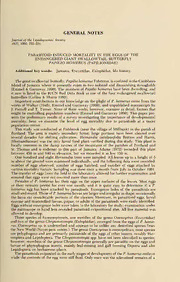
Parasitoid induced mortality in the eggs of the endangered giant swallowtail butterfly Papilio homerus (Papilionidae) PDF
Preview Parasitoid induced mortality in the eggs of the endangered giant swallowtail butterfly Papilio homerus (Papilionidae)
GENERAL NOTES JournaloftheLepidopterists'Society 46(3), 1992, 233-234 PARASITOID INDUCED MORTALITY IN THE EGGS OF THE ENDANGERED GIANT SWALLOWTAIL BUTTERFLY PAPILIO HOMERUS (PAPILIONIDAE) Additional key words: Jamaica, Encyrtidae, Eulophidae, life history. Thegiantswallowtailbutterfly,PapiliohomerusFabricius, isconfinedtotheCaribbean Island of Jamaica where it presently exists in two isolated and diminishing strongholds (Emmel & Garraway 1990). The numbers ofPapilio homerus have been dwindling, and it now is listed in the lUCN Red Data Book as one of the four endangered swallowtail butterflies (Collins & Morris 1985). Important contributions to our knowledge on the plight of P. homerus come from the works of Walker (1945), Emmel and Garraway (1990), and unpublished manuscripts by J. Parnell and T. Turner. None of these works, however, examine in detail, factors that might be controlling population numbers (Emmel and Garraway 1990). This paper pre- sents the preliminary results of a survey investigating the importance of developmental mortality; here we examine the level of egg mortality due to parasitoids at a major population center. This study was conducted at Fishbrook (near the village of Millbank) in the parish of Portland. The area is mainly secondary forest; large portions have been cleared over several decades for shifting cultivation. Hernandia catalpaefolia Britton and Harris, (Hernandiaceae) was the only larval food plant verified during this study. This plant is locally common in the damp ravines of the mountains of the parishes of Portland and St. Thomas and is endemic to this part of Jamaica. Adams (1972) recorded this plant between 450 m and 640 m elevation, but we recorded it as low 150 m. One hundred and eight Hernandia trees were sampled. All leaves up to a height of 3 m above the ground were examined individually, and the following data were recorded: number of eggs observed, number of eggs hatched, and number of eggs attacked by various mortality factors. Sampling was done once a month from July to October 1991. The transfer of eggs from the field to thelaboratory allowed for further examinationand ensured that eggs were not counted more than once. Females of P. homerus lay their eggs on the upper surfaces of the leaves. Most eggs or their remains persist for over one month, and it is quite easy to determine if a P. homerus egg has been attacked by parasitoids. Emergence holes of the parasitoids are smallandround. ThoseofP.homeruslarvaearelargerandirregularinshape;occasionally the larva eat considerable portions of the chorion. Moreover, in parasitized eggs, larval exuviae and mummified larvae, pupae, oradults of the parasitoids were easily identified. Eggswithout emergence holesweretaken tothe laboratory forstudy; examination under the microscope or hand lens revealed parasitoid ovipositional sites. All live material was allowed to develop. Three species of hymenopterans, one member of the genus Ooencyrtus (Encyrtidae) and twoof the genus Chrysonotomyia (Eulophidae), emerged from theeggsofP. home- rus. Ooencyrtus sp. is undescribed and appears to be unlike any described species from theNewWorld(Noyespers. comm.). ThegenusOoencyrtusiscosmopolitan; mostspecies are polyphagous and are primarily parasitoids of the eggs of other insects, notably Het- eroptera and Lepidoptera. The Chrysonotomyia spp. have notbeen identified tospecies; however, members of the genus Chrysonotomyia generally are parasitic on the eggsand larvae of phytophagous insects, mainly leaf-mining and gall forming Diptera and also Lepidoptera on herbaceous plants. TheparasitoidsovipositedintheearlystagesofdevelopmentoftheP.homerusembryo while the contents of the egg were still fluid. Only once was the sclerotized remains of a 234 Journal of the Lepidopterists' Society Table 1. Mortality of P. homerus eggs caused by parasitoids at Fishbrook, July to October 1992. No.of %eggs %eggs %other Month eggs hatched parasitized mortality July 258 9.3 79.5 11.2 August 108 17.6 71.3 11.1 September 63 19.0 76.2 4.8 October 14 7.1 64.3 28.6 Total 443 Mean 12.6 76.5 10.8 P. homerus larva discernible in the remains of a parasitized egg. The larvae of the parasitoids generally consumed the contents of the egg and between 10 and 18 adult parasitoids generally emerged. The parasitoids resulted in 76.5% (n = 443) egg mortality during the months July to October (Table 1). This is a significant portion of the 87.4% total egg mortality. The remaining 10.9% mortality was caused by fungus and a number of unidentified factors. While the true role of the eggparasitoids isfar from resolved, the76.5% egg mortality they caused in this case is significant for an animal with extremely low densities. This suggests a very high efficiency in searching for P. homerus eggs or the possibility of alternate hosts that maintain the population of parasitoids at high levels. As pointed out by Parsons (1984), parasitoids breeding in a common alternate host may adversely affect the survival of a rare species. We thank the Jamaica Agricultural Research Programme for financial support, and J. S. Noyes and J. LaSalle of the Commonwealth Institute of Entomology for identifying the parasitoids. Literature Cited Adams,C. D. 1972. FloweringplantsofJamaica. UniversityoftheWestIndies,Jamaica. 848 pp. Collins, N. M. & M. G. Morris. 1985. Threatenedswallowtailbutterfliesoftheworld: The lUCN Red Data Book. lUCN, Cambridge: 401 pp. Emmel,T. C. & E. Garraway. 1990. Ecologyandconservationbiologyofthehomerus swallowtail in Jamaica (Lepidoptera: Papilionidae). Trop. Lepid. 1:63-76. Parsons, M. 1984. The biology and conservation of Ornithoptera alexandrea, pp. J. 327-331. In Vane-Wright, R. I. & P. R. Ackery (eds.). The biology of butterflies. Academic Press, London. Walker, D. R. 1945. Papilio homerus. Nat. Hist. Notes of Nat. Hist. Soc. ofJamaica J. 1:161-163. Eric Garraway and Audette J. A. Bailey,WDepartment ofZoology, University of the West Indies, Mona, Kingston 7, Jamaica, .1. Receivedfor publication 22 January 1992; revised and accepted 1 June 1992.
